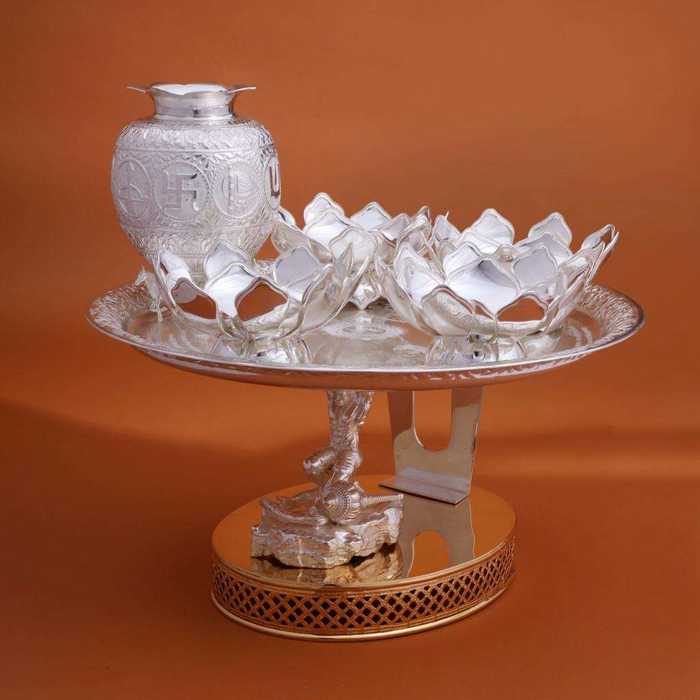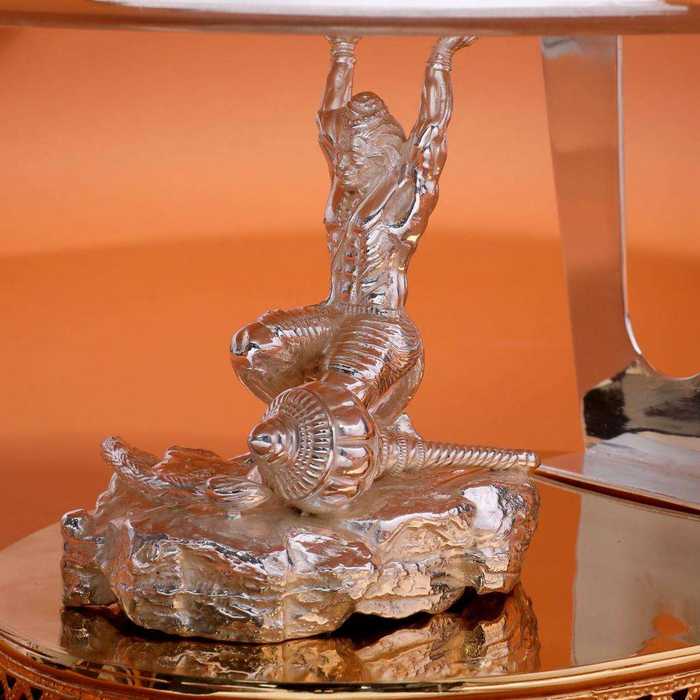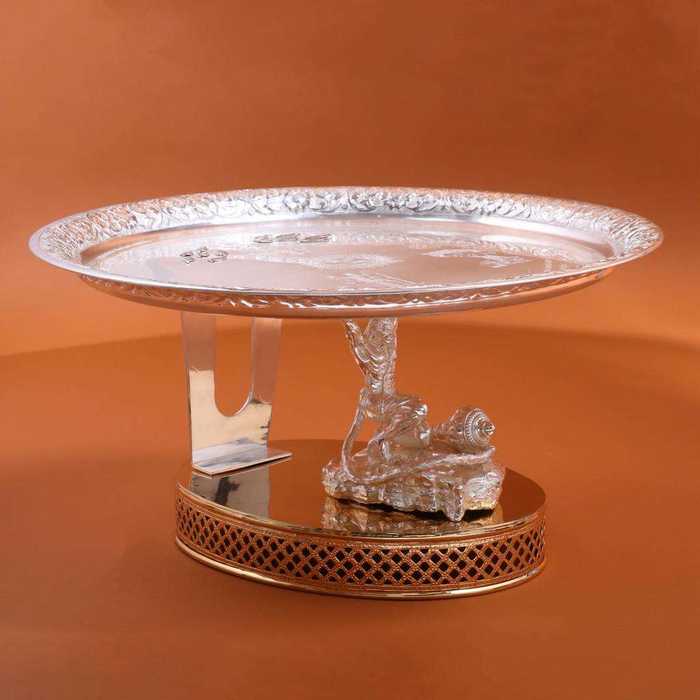Published 19:36 IST, January 15th 2024
Bhog Thal of Ram Lalla, Featuring 21-Petalled Lotus Bowls, Engraved with Sunder Kand Verses | PICS
The captivating carving on Bhog Thal adds layers of significance, highlighting Lord Ram's unwavering commitment to love, compassion, and religious principles.
- India News
- 5 min read
Full-fledged preparations in motion ahead of the grand opening and consecration ceremony of the Ram Temple, featuring the installation of Ram Lalla on January 22. The mega event is set to attract dignitaries and individuals from diverse backgrounds. A unique Bhog offering plate, crafted by dedicated artisans in Jaipur, Rajasthan, adds a distinctive touch to the occasion.
Iris head Lakshya Pabuwal, along with co-founder Rajeev Pabuwal, designed a remarkable silver Bhog Thal for Ram Lala. This 18-inch diameter plate is intricately adorned with representations of Lord Hanuman and features an engraving of 15 verses from the 35th canto of Sunderkand. These verses celebrate the divine qualities of Lord Ram and Lakshmana.

Today, in the presence of General Secretary of Shri Ram Janmabhoomi Teerth Kshetra Champat Rai, Lakshya Pabuwal dedicated this special plate to the Janmabhoomi temple. The elaborate craftsmanship and symbolic engravings on the Bhog Thal commemorate the anticipated installation of Ram Lalla's statue, enhancing the significance of the forthcoming event.
Spiritual significance of Bhog Thaal
In an intricate display of spiritual symbolism, the captivating carving on the Bhog Thal adds layers of significance, highlighting Lord Ram's unwavering commitment to love, compassion, and religious principles.
The Bhog Thal, comprising four lotus-shaped bowls dedicated to daily offerings to Ram Lalla in the Ayodhya temple, carries profound spiritual connotations. Each bowl, adorned with 21 petals, symbolises spiritual urgency, drawing on the symbolism of the lotus and the significance of the number 21. The lotus, laden with divine symbols, serves as a vessel for delivering offerings and devotion to God. The 21 petals convey completeness and perfection, reflecting the preciousness of Lord Ram in his divinity.

The number 21 holds significance in various aspects of Hindu tradition. In astrology, it signifies the influence of the seven planets on the three gunas – Sattva, Rajas, and Tamas – across the three worlds, creating a holistic impact. In Acharya practices, the number 21 contributes to a comprehensive worship of mantras, recitations, and offerings, symbolizing righteousness and prosperity.
As Lord Ram's favorite flower, the lotus is intricately linked to his life and teachings, representing purity, divine form, and spiritual awareness. The Bhog Thal, adorned with 21-petalled lotus-shaped bowls, serves as a sacred vessel dedicated to Lord Ram, embodying a sense of completeness, purity, and religious homage.
The Bhog Thal, enriched with gold and featuring four Bhoga bowls, assumes the role of a unique treasure — a shining golden Kalash, supported by the divine power of four magnificent horses pulling the chariot of Lord Ram. Around this sacred vehicle, nine symbols intricately tell tales of divine significance.
The number 9, deeply ingrained in Hinduism, particularly corresponds to the life and stories of Lord Ram. Traditionally, 9 symbolises completion, attainment, and perfection across various aspects. In the context of Lord Ram, the number 9 represents Navarasa (nine emotions), Navadha Bhakti (nine forms of devotion), Navagraha (nine planets), and Navadurga (nine forms of Durga), among others.
With the association of the number 9 with Lord Ram, it aligns with the nine days of worship during Navratri, dedicated to the divine goddess and the nine forms of Durga. Additionally, Lord Ram's revered bow, Kodanda, is said to be crafted from nine materials, symbolising power, dharma, and divinity.

Significance of Sun God representation
Enhancing the divine atmosphere, the Bhog Thal's focal point features a carved representation of the Sun God, symbolising reverence for Lord Ram, believed to be of the Suryavansh lineage. In the spiritual narrative, Lord Ram, accompanied by Saint Agastya, discovers divine power, confidence, and victory through their connection with the Sun God. To commemorate this profound bond, Saint Agastya and Lord Ram composed the - Aditya Hridaya Stotra. Within this celestial tableau, the image of the Sun God is surrounded by three captivating depictions of Lord Ram, further enriching the ongoing heavenly tale:
Divine union with Sita
In this mesmerising statue, Lord Ram and Goddess Sita share an ethereal embrace, symbolising a love that transcends time and space. Their eyes meet, revealing an unbreakable bond of constant devotion and utmost respect. Ram's unwavering commitment is manifested in the following forms:
- Sammanmay Puja: To honor Mother Sita as divine love and power.
- Sanrakshak Rakshak: Standing as her unbreakable shield, protecting her dignity and honor
- Anavarat Samarthan: Providing unwavering support through his trials and triumphs.
- Nishkaam Balidaan: To offer sacrifice, to be ready to give up personal happiness for the sake of Sita.
- Atulaneey Bhakti: Shining with peerless dedication, setting an example of eternal devotion. This image summarizes the significance of Ram's fierce and selfless love for Sita.
Aasthaan Gilaharee Kee Daya
In the serene surroundings of the ancient forest, Lord Ram's face is a shadow of divine grace as he lovingly caresses a small squirrel sitting in his palm with his loving hands. The squirrel, a symbol of humility and devotion, soaks in the warmth of Ram's love. Mythology tells that the squirrel came to have three distinctive, delicate white lines on its back — a symbol of recognition of the smallest signs of divine love and devotion.
Anant Karuna Ka Niyam
Imagine the unique image of generosity, where Lord Ram extends his hand to help anyone in need, exchanging his royal power, power, and service to every soul in Ayodhya. His rule of 11,000 years, where every day resembled an era, shows the deep impact of his love and devotion on the lives of his subjects. His kingdom was not just about rule; It was a story of transformation that lifted up the helpless, provided solace to the suffering, and brought hope to a turbulent time.
Updated 19:36 IST, January 15th 2024